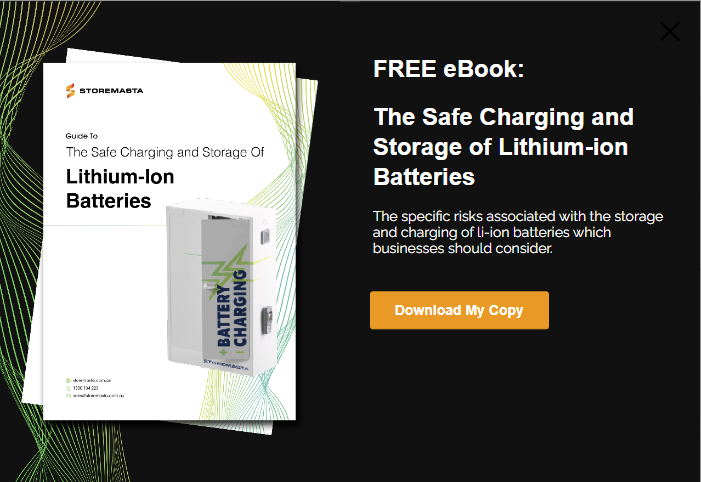With lithium-ion batteries powering devices, equipment, vehicles and new technologies, it’s important to understand how ambient temperature can affect the safety and performance of the battery. Room temperatures can directly affect the temperature inside the lithium-ion battery — and this will affect how safe the battery is and how it performs. In this blog, we’ll be discussing the effects of temperature on lithium-ion batteries and what this means for your handling, charging and storage practices.
How Do Lithium-ion Batteries Operate?
Lithium-ion batteries operate through the movement of ions between the positive and negative electrodes. When the battery is discharging, the negative electrode moves through the electrolyte to the positive electrode. The process is then reversed when the lithium-ion battery is being recharged.
During this complex process, many factors can decrease the battery performance and its safety. The ambient temperature of the battery storage area —as well as li ion battery handling and charging/discharging practices — can all adversely affect the stability of the battery cell.
We’ll discuss each of these factors in further detail below, but let’s first look at the recommended temperature for the use and storage of lithium-ion batteries.

Many factors, including temperature, can affect the chemical reactions within li ion batteries.
What Temperature Is Ideal For Lithium-ion Batteries?
Lithium-ion batteries should be ideally stored in cool, dry conditions at a temperature of 15°C. The general temperature range for lithium-ion cells lies between 5°C and 20°C. If temperatures are too cold, such as 0°C, it can result in a loss of capacity due to the chemical reactions inside the battery slowing down due to the low temperature. If conditions are too hot, it can result in hazards such as fire and explosion.
Just like any type of hazardous chemical or substance, it’s vital that you always read and follow the manufacturer’s instructions when handling, charging and storing your lithium-ion batteries.
REMEMBER: Keeping batteries at a safe temperature can be difficult in a hot environment such as Australia. That’s why it’s crucial to consider storage options that include temperature control measures which can reduce humidity and heat.
What Risks Are Associated With Extreme Storage Temperatures?
So, what temperature is bad for lithium batteries?
In the simplest of terms, the lithium ion battery storage temperature has a direct effect on the chemical reaction within the battery cell.
Very low temperatures can produce a reduction in the energy and power capabilities of lithium-ion batteries. High ambient temperatures, however, can contribute to a high internal temperature of the battery — which can also decrease performance and power capabilities.
In addition to this issue, high ambient temperatures produce further complications and risks. If the temperature reaches a critical point, thermal runaway can be triggered in the li ion battery.
IMPORTANT: So, how does heat affect lithium batteries and what risks does this pose to your worksite? We answer these questions and more in our free battery safety eBook. Get your copy today.
High Temperatures and Thermal Runaway
Thermal runaway occurs when the heat generation within the battery cell exceeds the heat dissipation capacity. Thermal runaway often occurs at high temperatures as they can trigger exothermic reactions in the battery.
As the reactions produce more heat and increase battery temperature, it can lead to the destruction of the battery, as well as workplace fires and explosions.

Thermal runaway in li ion batteries can be prevented with proper handling and storage practices.
Is your organisation storing large quantities of lithium-ion batteries? Then you must also be aware of the issue of cascading thermal runaway. This occurs when other battery cells, stored close to the affected battery, also succumb to the elevated temperatures. This domino effect of thermal runaway contributes to the serious fire and explosion hazards already posed by the affected battery cell.
Fires involving lithium-ion batteries are known to be intense, fast burning and extremely difficult to put out. Lithium battery fires are also capable of producing large volumes of toxic fumes — which are hazardous for human health. Every precaution should be taken to avoid such an incident occurring in your workplace.
Discover the latest in Battery Management
How To Reduce Risk
Whether you’re working with just a few lithium-ion batteries, or your business relies on a large store of batteries, careful work practices must be followed to reduce risk.
First and foremost, lithium-ion batteries should be handled in accordance with the manufacturer's specifications. You should pay attention to the instructions regarding the safe limits for maximum current load, charging, and end-point voltages, as well as thermal load.
Here are some general tips for the safe handling, maintenance, storage and charging of lithium-ion batteries.
General Care and Maintenance
If batteries aren’t handled properly, it can result in personal injury, property damage and environmental pollution.
Great care should be taken to ensure that batteries don’t suffer any kind of damage. This means handling the batteries carefully, not stacking them in storage, and ensure they’re not left lying around loose on shelves or desks. Damage can occur if batteries are dropped, knocked or exposed to sunlight or excessive heat.
Don’t use excessive force when trying to remove or install batteries in a device. If you notice an old, leaking, damaged or swollen battery, it should be safely disposed of immediately as this can present an immediate risk.
When batteries are in use, make sure that the device or equipment that they’re powering, is not subject to excessive heat. You shouldn’t overcharge a lithium-ion battery; instead make sure it’s unplugged once it’s reached the desired state of charge. Not only can overcharging lead to safety issues, it will also shorten the lifespan of li ion batteries.
State Of Charge
When you’re about to store your lithium-ion batteries, you should also make sure that they’re at a recommended state of charge.
Many lithium-ion batteries are best stored at approximately 40% state of charge. Failure to store your batteries at this rate may contribute to cell instability. However, the manufacturer’s instructions should provide you with more detailed advice on the particulars of storing your battery product.
The Ultimate Handbook is your complete guide to safe storage.
The average lifecycle of a lithium-ion battery is around 300 to 500 charge and discharge cycles. However, the age of the battery, the temperature at which it is kept, and how cycling occurs can decrease battery performance. Overcharging, excessive charging voltages, and non-compliant battery chargers should be avoided when recharging your lithium-ion batteries.
Storage Conditions
Li ion batteries should be stored in a cool, dry and well-ventilated area that is away from direct sunlight and any heat or ignition sources. You must ensure that your storage area is always kept at a stable temperature — ideally between 5 - 20°C.
Make sure that your batteries are stored (and charged) in an environment with adequate cooling, so they remain within the safe ambient temperature range — at all times.
Lithium-ion batteries should be stored in an environment that is cool, dry and safe from impact damage and other hazards.
Look for battery cabinets with temperature-control features including built-in fans, natural ventilation and sheet steel construction with a thermal air barrier. This will provide a cooler, drier environment to charge and store your lithium-ion batteries.
Heat and Fire Protection
As we’ve explained, extreme heat can be extremely dangerous for businesses who use and store lithium-ion batteries. However, if a fire does break out while charging your batteries, it’s essential that the fire is contained as much as possible. An uncontained lithium-ion battery fire can quickly consume a workplace — and spread to the surrounding environment and local community. The extreme heat of the fire can also pose serious risks to staff, including battery components exploding with considerable force.
Heat and fire protection for battery stores is an essential risk control measure. The barrier helps, for a short period of time, to contain a lithium-ion battery fire within the cabinet. This small window of time allows evacuation procedures to be actioned and emergency services to be notified.
Storing Batteries at a Safe Temperature
Thermal runaway, in a single battery cell or in multiple batteries stored close together, can produce fires and explosions that affect not only your organisation but the wider community. That’s why it’s so important to understand how to protect your business from this serious risk. Storing and charging your batteries in a controlled environment at a safe ambient temperature is one of the most significant things you can do to reduce the risk of fire and explosion.
If you’d like to learn more about reducing risks with your lithium-ion batteries, you can access our helpful guide. Guide to the Safe Charging and Storage of Lithium-ion Batteries will introduce you to our 4-step risk control methodology and provide you with the framework to control battery risks in your own workplace. Grab your copy for free today by clicking on the image below.

Living life by the 4 C’s of marketing – communication, coffee, compliance… and more coffee – Leisa Andersen is Storemasta’s Content Marketing Manager. When she’s not writing, you’ll find her enjoying all the good things in life, including shopping, travel and gluten free donuts.
